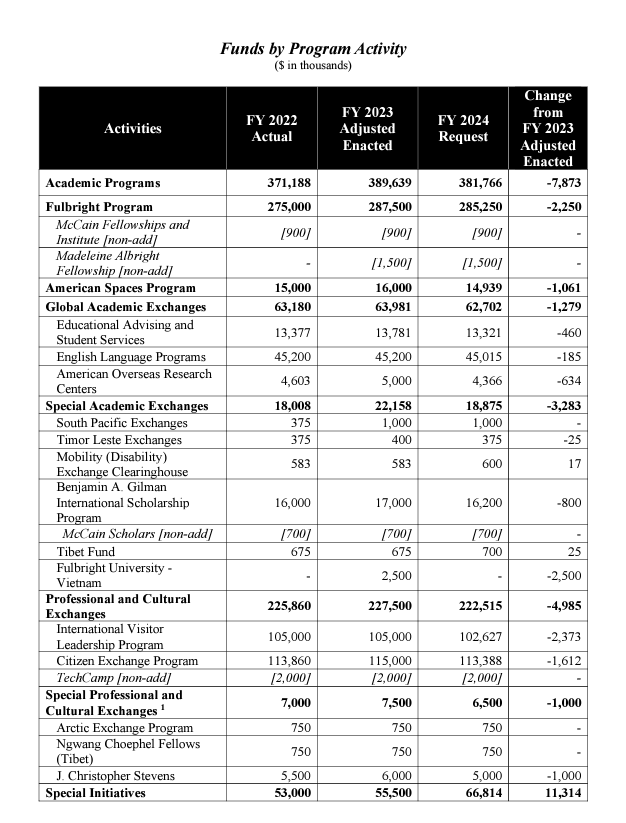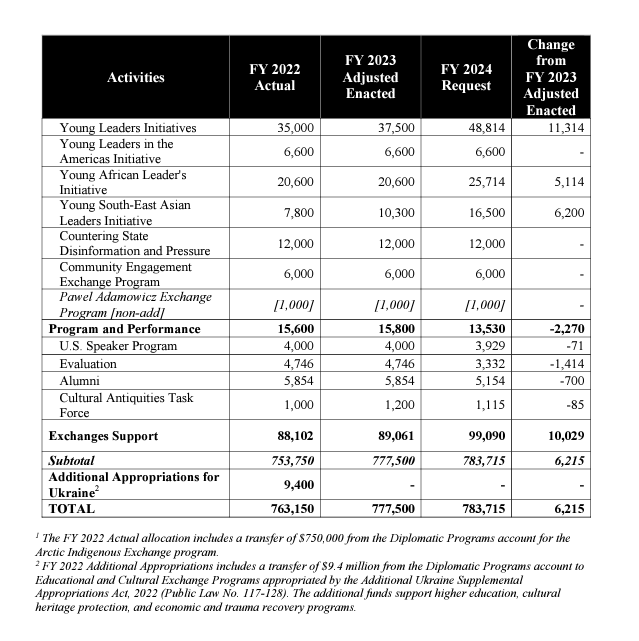By Andrea Bodine
The Fiscal Year 2024 (FY24) appropriations cycle is officially in full swing with the release of the Biden Administration’s proposed budget late last week. The President’s $6.8 trillion request, while unlikely to be enacted in the current divided Congress, presents a starting point for the negotiations to come.
The FY24 proposed budget includes $70.6 billion (an $8.9 billion increase compared to FY23) in discretionary non-emergency funding for the International Affairs Budget. As a portion of this larger international affairs funding, State Department Educational and Cultural Exchange (ECE) programs are budgeted at $783.7 million, a $6.2 million (0.8%) increase from the current FY23 enacted level of $777.5 million.
In reviewing the State Department’s Congressional Budget Justification (CBJ, pg. 57-61), there are three notable takeaways:
- The proposed ECE budget has an overall increase, but the majority of flagship ECA programs include cuts.
While this year’s topline request is approximately $6 million more than current funding, a closer look shows that it includes cuts across the board to key programs like Fulbright (-$2.25M), Gilman (-$800k), and IVLP (-$2.73M). See specific line items in the table below. - Majority of increased funding goes toward the Young Leaders Initiatives and Exchanges Support.
The main areas of increased investment include the Young African Leader’s Initiative (+$5.1M), Young South-East Asian Leaders Initiative (+$6.2M), and Exchanges Support (+$10M). The CBJ notes that the additional funding for Exchanges Support is devoted to “the FY 2024 projected American Pay Raise, one new position to support YSEALI, IT modernization, and various working capital funds and other IT support charges.” - The language around programming focuses on competing with China and Russia, which is in line with the proposals for the International Affairs Budget as a whole.
The justifications for both the Academic Programs and Professional and Cultural Exchanges requests highlight that funding in these areas is needed to help the U.S. compete with China and Russia in attracting international students, as well as presenting alternatives to their influence vis-à-vis sharing American values around the world. This emphasis fits into the larger picture of the Administration using the resources proposed in the International Affairs Budget as a means to counter Chinese global influence and support Eastern Europe against Russian authoritarianism, which is well outlined in USGLC’s budget analysis.
While an increased topline request for exchanges is positive, the proposed cuts to ECA’s flagship programs referenced above would hinder the ability of exchange programs to meet the goals set by the Administration.
As a result, the Administration’s request reinforces the importance of our continued advocacy efforts during the FY24 cycle. In our advocacy activities over the coming weeks and months, we will continue to promote our community’s request for ECE funding at $855 million.


